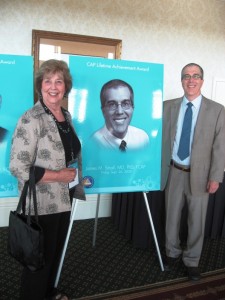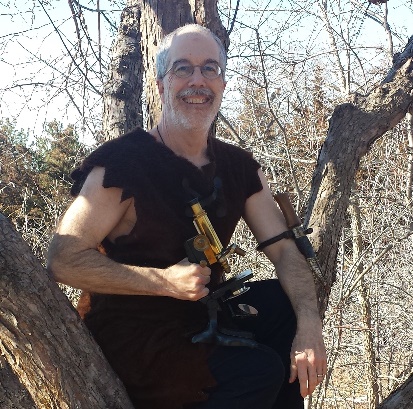There’s just no doubt that everyone out there is clamoring to know more about what a pathologist does in a cancer hospital! We are definitely not CSI Forensic pathologists, who can figure out by DNA who the perpetrator was before the next commercial break. So as a public service PaleoPathologist, recipient of a 2008 Lifetime Achievement Award by the College of American Pathologists, has decided to describe in excruciating detail my day.
Last night PaleoPathologist went to TruFit Health of Denver for the first time in three weeks. Weights were all the same and times were the same or better. At this point, it’s horizontal row, chest press, lat pulldown, low back machine, leg press, and an infimetric rotator cuff sequence. Then came carb nite with a sandwich, chocolate milkshake, and an oatmeal cookie to rebuild glycogen levels. Then Incredible Wife (IW) and I went to see an unnatural but creative cinematic mating of Groundhog Day and Starship Troopers: Edge of Tomorrow. Loved it.
Why, one might ask, does this post about my day start with the night before? PaleoPathologist went to a conference several years ago about re-energizing, finding your call again, and one of the speakers mentioned that the Hebrew concept of “day” begins at sunset, NOT at Midnight or Sunrise (or in the case of some particularly disturbed surgeons PaleoPathologist works with, 4:30 AM.) So really today started last night, with The Incredible Wife, a nice meal, thought provoking entertainment with conversation in the chariot after, and sleep.
This morning, after a cup of Illy coffee and a nice slice of PaleoPathologist elk sausage frittatta, the day began at Porter Adventist Hospital department of Pathology. I try each morning to take fifteen minutes in meditative prayer and looking at some of the things I would like to get done. Today there are only two pathologists on duty and we have a busy day, but so what, the prayer makes the rest of the day possible. Michael Hyatt has a nice post on Morning Rituals to get the day started right. Mine is starting out with waking, coffee/breakfast, prayer, going over the day’s objectives, and heading for work.
Most days start out with a pile of microscope slides from the previous day’s cases. PaleoPathologist today had slides from abdominal fluid on a guy with bad liver disease, a thyroidectomy for cancer with three different tumors in it, a bad case of allergic sinusitis, a tongue resection for cancer with multiple positive lymph nodes in the neck, and a hysterectomy on a woman with Lynch syndrome (a hereditary condition that increases the risk of cancer.) She ended up having a surprise cancer in her ovary, but it is completely contained in the ovary and is probably cured.
A knock and the door and Eric announces a frozen section. Frozen sections occur when a surgeon needs PaleoPathologist guidance during his surgery case. We take the tissue and quick freeze it in a cryostat, a device that allows us to cut very thin sections, stain them in a couple of minutes, and look at them under the microscope. We then call the surgeon in the operating room and let them know where they stand. In this case, a young man has a squamous cell cancer at the base of his tongue, probably caused by human papilloma virus. Our surgeons can really bury us with frozen sections. Last November, two of us pathologists looked at 131 frozen section slides in one day, in addition to taking care of the other work. That is an OUTRAGEOUS number of frozen sections; a friend told me that his personal record at a huge teaching hospital in Boston was…54.
PaleoPathologist daughter then showed up with the truly incredible PaleoPathologist grandson to pick up some requisitions to get some lab work done, then back to the microsope to dictate some reports.
OOPS. More frozens on the tongue case; so far, all margins negative–hoorah. A “margin” is the space between the tumor and the cut edge the surgeon has taken, so a negative margin means the surgeon has completely removed the tumor that we can see.
PaleoPathologist got back to work at 11:15, looked at some more slides, when Devan came in and announced that Radiology had called with two thyroid biopsies and a CT-guided lung biopsy, and who would like to go? PaleoPathologist said he would be delighted, and to please let me know when they call, ready for the cases.
Oops, More frozens until noon! We are now over 40 slides; a light day at Porter Adventist. Last margin is free. PaleoPathologist dashes upstairs to get an Americano with heavy cream, two slices of cheese, and a handful of mixed nuts, naturally with no peanuts. When you are fat-adapted instead of carb-addicted, skipping a meal turns out to be not a particularly big deal. When he arrives back from his five minute dash his enthusiastic young partner has already taken the cart to Ultrasound to assist with the first thyroid biopsy!
More routine slides, more dictating. The second thyroid fine needle aspiration biopsy comes and goes. The CT-guided lung biopsy arrives on a woman with Breast cancer history, Lung cancer history and another more mysterious diagnosis that PaleoPathologist will have to investigate further on Monday. Back to dictating.
Phone rings. A long time friend and colleague calls asking PaleoPathologist to please take another look at a case, but the slides have been loaned to another hospital for their pathologists to review. This goes on the “waiting for” list. (If you aren’t familiar with Getting Things Done by David Allen, PaleoPathologist strongly urges you to pick up a copy. As a spear or stone knife was in paleolithic times, so is Getting Things done in this Infolithic era we find ourselves inhabiting: an essential survival tool. The waiting for list has saved PaleoPathologist’s hairy hide more than once.)
A couple more slides, the pile is slowly shrinking, PaleoPathologist continues talking into the magic device that sends his voice through copper wires to people who transcribe his utterances into words in the computer. Amazing, really. Arthur C. Clarke, who actually wrote about some of PaleoPathologist’s ancestors in 2001: A Space Odyssey, once said, “Any sufficently advanced technology is indistinguishable from magic.”
An almost apologetic knock. One of my favorite oncologists appears at the door to talk. PaleoPathologist used to call this “an interruption” and resent it. After reading David Allen, I now consider this “work that shows up.” It is quite amazing, actually, how helpful this can be in stress management. PaleoPathologist signed up for a job where people need him on a moment’s notice; the “interruptions” ARE his job. We discuss the woman with the lung biopsy mentioned above, and then PaleoPathologist turns, once again, to the microscope.
PaleoPathologist sits back briefly and turns around. His inbox now contains more slides! Eric has delivered ten abnormal Paps for interpretation. Many pathologists consider paps to be a routine annoyance, but PaleoPathologist has a wife (actually The Incredible Wife) and three fabulous daughters and recognizes that these annual samplings save a lot of women’s lives these days. Also, I have visited countries on mission trips where no pap screening really exists and cancer of the uterine cervix rivals breast cancer as a killer of women. So I take them to the scope, take a look, photograph the abnormal ones, and scan the worksheets to more transcribers using the Fujitsu Scansnap. The Scansnap is fabulous, more magic.
We are getting close now at 4 PM! Finally done dictating the major cases. Oh, wait, the Waiting For box is not empty! One of my ENT surgeons asked me to look at a case I had signed a couple of weeks ago. He had some questions about measurements of squamous cell carcinoma of the mouth to the margins, so the assistants pulled the three trays of 20 slides (a small ENT case…) and printed a report and brought it to PaleoPathologist for a second look and a dictated clarification of the report. An interruption? Technically, but it’s REALLY work that showed up, that was more important than some of the things on my list (“Predefined work,” according to David Allen) and it will make a difference to the surgeon and most important to the patient.
Oh, yeah, the patient with the unexpected cancer in the ovary! I’ve got to call the surgeon and we have a little discussion about the additional work that needs doing before I can finalize the report.
The Pathologist Assistant comes by and asks if I would text the ENT surgeon, who has two more cases on the OR schedule, to see if he wants another frozen section. The Galaxy S4 beeps, sure as shooting, he needs another frozen and PaleoPathologist is on duty until 5:30 tonight. While in a theoretical sense it’s nice to be needed, it IS Friday at 4:45! So he won’t be home to IW quite as early as hoped, but IW was the assistant head nurse on the Duke Burn Unit and understands.
While awaiting the specimen, PaleoPathologist pulls out his PM checklist written on a Green index card, and pulls up his cases on the Hospital computer system, proofreads them, and sends them on their way to the clinicians. He loves getting cases out at 24 hours; there is an infinitely valuable creation of God on the other end of every slide, who is scared and waiting for the result. Similarly, he pulls up the paps on another computer system and signs THOSE out.
5:05 and the Lab Director stops by, a bit more work showing up. PaleoPathologist is the Medical Director of the lab and takes it seriously, so he has an open door policy as much as possible. The Director has a brief question about a new procedure, a change from the older one that may save time and money but may not be as sensitive a test, and we agree to look into it.
Frozen arrives! The Pathologist Assistant, a blessed angel, has done the cutting, staining, and paperwork and the slide is awaiting me by the scope. One look: it’s cancer, unfortunately. PaleoPathologist reminds himself that “he didn’t make the news, he just reported it.” Last frozen of the day.
Now he pulls out the list he made, full of hope, at the beginning of the day. This was called, in David Allen terms, “defining my work.” PaleoPathologist decides to check something, anything, off the list and so pulls up laboratory procedures that need proofreading and signing. Half an hour of that and there are no more pending procedures. I wish this was in stone and chisel sometimes because it is a triumph to check things off the list. Just drawing through it with the PaleoPathologist fountain pen is not quite enough of a celebration.
PaleoPathologist sends a note to his Coach about how the day went. PaleoPathologist is beginning to learn the value of an outside perspective, good questions, and even a bit of (dare I say it) accountability in this life. We are tribal/pack animals, more like wolves than mountain lions, and we do better when we remember that.
5:40 PM, PaleoPathologist goes out to the chariot and heads home to IW for a nice Liver dinner. Tired but triumphant–the day is done, patients have been helped, flint axes, burning torches, and pointed spears have been successfully juggled, life at Porter Pathology has been successfully moved forward and now it’s time to settle down and reconnect with PaleoPathologistMate!
note: added later; still learning how to do this well. I also reviewed several abnormal blood smears from the clinical lab, another thing PaleoPathologist does most days. How does this sound? Am I forgiven for not blogging every day???

Please note: I reserve the right to delete comments that are offensive or off-topic.